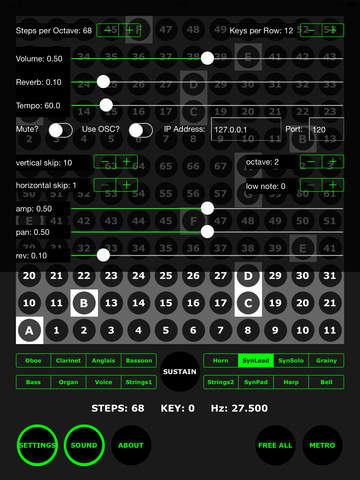 Op 133 Studios has introduced MicroSketch – an iPad music app for playing and experimenting with equal divisions of the octave other than the standard 12-tone scale.
Op 133 Studios has introduced MicroSketch – an iPad music app for playing and experimenting with equal divisions of the octave other than the standard 12-tone scale.
WIth MicroSketch, octave divisions can be anything from 7 to 96.
The app is polyphonic up to the capabilities of your device’s processor (typically 24 voices) and multi-timbral with 16 ‘instrumental’ timbres.
The instruments are all fully synthesized (no samples!) using subtractive, additive, frequency modulation, the Karplus-Strong string model, VoSim, and granular synthesis techniques.
The microSketch keyboard can have a variable number of keys arranged in a square from 5 by 5 up to 15 by 15. The keyboard is isomorphic, with the horizontal and vertical interval set independently for each instrument.
Other properties of the instruments can also be set independently, like the pan position, amplitude, and reverb mix amount. The bottom note for each instrument can also be set.
Each instrument can be set in ‘Sustain’ mode, where a key touch turns a note on, and another key touch releases the note. For some instruments, the ‘Sustain’ mode gives you a variation on that instrument.
Video demos are available at the developer’s site.
microSketch is US $4.99 in the App Store.
If you’ve used microSketch, let us know what you think of it!

Just bought it , and I love it ! it s perfect to discover new sounds , in a sense that now there is way more chords , arpeggios , modes , and over all scales to compose with. The sounds are terrible though (there s a granular patch with randomized pitch , whats its purpose in an app where its all about the pitch?) . THANK GOD IT SENDS OUT OSC. That makes it worth my money. A nice plus for an update would be the ability to glide between notes.
Does it output MIDI? Or rather, could I use this to control any hardware?
Great concept, and a very nice way to get a feel for microtonal melodies.
Problems:
* unwanted “stuck notes” are common (the “free all” button seems like a hack-y solution for something that shouldn’t happen to begin with)
* the different presets might as well be ROMpler PCM samples, they offer 0 control over any aspect. It would have been more interesting if they just had a vanilla subtractive synth + a few samples to play, and the quality of the sounds are not the best
* can’t use it to control other synths (if this were possible, it would make up for all else.)
It’s a synth using a very exciting concept, with a very unimpressive soundset (no synthesis engine you can control) and semi-glitchy interface. Again, I would prefer samples to 5-6 “synthesis engines” the user has 0 control over.
Price point would make more sense at $1-3, if they added a more fleshed out synth engine and midi out (to control other synths), they could sell it for 10-20.
Using this with my Streichfett and creating nothing but wonderful full colorful walls of sonic heaven
Is there anything like this for iOS that allows arbitrary divisions of intervals other than the octave? I was listening to Wendy Carlos’ _Beauty In The Beast_ the other day, which uses some microtonal scales that divide across 3rds and 4ths (I think) so you get (for instance) 18.75 notes per octave.
so does it have MIDI out or not?
How do you use OSC? I can’t figure out how to get it to talk to my iMac.
Thanks for checking this out everyone. We are currently working on MIDI output and AudioBus integration. iOS 8 and AudioBus is proving a little trickier then we hoped, but an update should be out with both soon. Cheers!
The version with MIDI out is now in the iOS store. AudioBus implementation should be coming soon. For the question about OSC – what are you using to receive OSC? If you have ever used SuperCollider, there is a quark that does the heavy lifting for you (and help files). Let me know what you are using, and I can try to point you in the right direction.
How do I record it?
Can midi control with animoog
1.2 came out a couple days ago, so both MIDI and AudioBus are now working. Next update will be longer, since we are planning a rewrite of the underlying engine to try and incorporate other suggestions. Thanks!